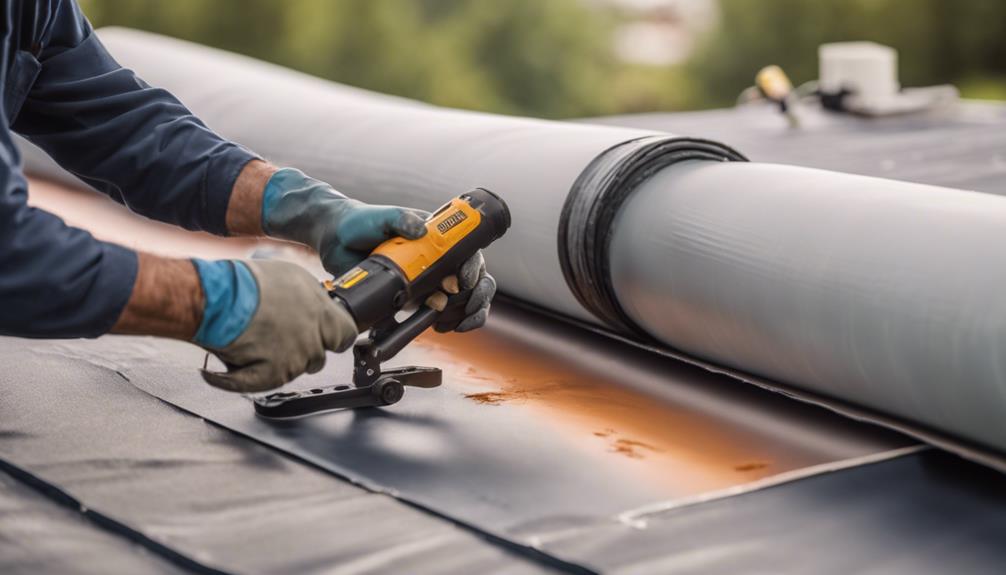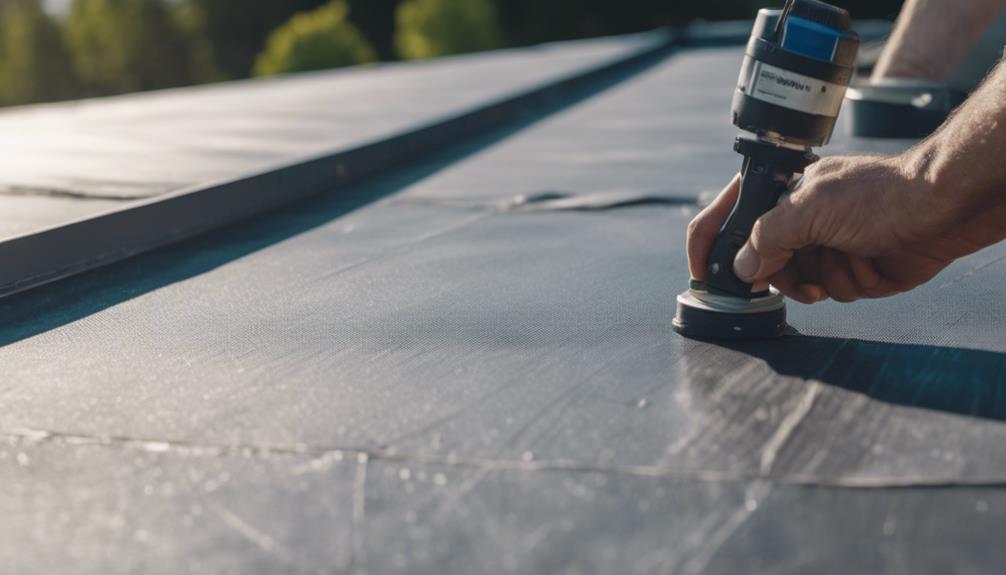How Do You Perform Regular Maintenance on Single Ply Roofing?
Curious about how to enhance the longevity of your single ply roofing system?
Regular inspections and proper cleaning are essential steps to keep your roof in top condition. However, many people overlook the importance of creating a detailed maintenance plan, which serves as a guide to address problems quickly and efficiently, ultimately saving time and money.
Conduct regular inspections, ideally biannually, to detect stress, detachment, debris, and damage early on. Inspect gutters for clogs and damage, check flashings for tight seals, and follow the manufacturer’s guidelines for the roofing materials. Remove debris like gravel and leaves, and clean the surface to prevent moisture buildup, algae, and mould. This maintenance preserves the system’s waterproofing and extends its longevity.
Understanding how to maintain single-ply roofing is key to its long-lasting performance. In this guide, we’ll go over the main strategies to boost the durability and effectiveness of single-ply roofing systems.
Why Are Routine Inspections Important for Single Ply Roofing?
Routine inspections are crucial for single ply roofing because they identify potential issues early, preventing costly repairs and ensuring the roof’s longevity. Inspections, conducted at least bi-annually, detect stress, detachment, debris, and damage, allowing for timely interventions. Post-storm inspections are vital to check for damage that may lead to water infiltration.
Early detection maximizes the service life of single-ply roofs and maintains their performance. By addressing problems promptly, routine inspections help keep the roof in optimal condition to withstand environmental elements.
Single-ply roofing membranes, such as TPO, PVC, and EPDM, are popular choices due to their durability and cost-effectiveness. However, without proper maintenance, these roofing systems can deteriorate prematurely, leading to leaks, structural damage, and costly repairs.
In addition to visual inspections, it is essential to conduct regular moisture surveys to detect any trapped moisture within the roofing assembly. Moisture can weaken the membrane and insulation, leading to mould growth and structural damage over time. By performing routine inspections and addressing any issues promptly, building owners can ensure their single-ply roofing systems remain in the best condition for years to come.
What Are the Best Practices for Maintaining Single Ply Roofing?
To maintain single-ply roofing systems effectively, employing appropriate cleaning techniques is important for preserving their integrity and performance over time. Proper cleaning not only enhances the aesthetics of the roof but also helps prevent damage and extends its lifespan. Prioritizing regular maintenance helps building owners mitigate neglect risks, ultimately saving time and resources.
Here are three key points for ensuring the cleanliness and longevity of single-ply roofing:
- Use Mild Cleaning Solutions: When cleaning single-ply roofing, avoid harsh chemicals that can degrade the membrane. Opt for mild detergents or specially formulated roof cleaners that are compatible with the roofing material.
- Soft Washing Method: Utilize a soft washing technique rather than high-pressure washing to prevent causing tears or punctures in the roofing membrane. Soft washing involves using low-pressure water combined with gentle cleaning agents to remove dirt and debris effectively.
- Regular Cleaning Schedule: Establish a routine cleaning schedule to prevent the buildup of debris, algae, or mould on the roof surface. Debris removal and cleaning are crucial for maintaining single-ply roofing systems. Regularly clear loose gravel, dirt, leaves, and twigs to prevent moisture buildup, which can lead to algae, mould, and standing water. This helps avoid structural damage and leaks, enhancing the roof’s longevity. Regular maintenance helps identify and address any issues promptly, maintaining the roof’s structural integrity.
- Inspecting The Gutters: Inspecting gutters and flashings on single-ply roofing ensures proper drainage and prevents water infiltration. Check gutters for clogs, proper alignment, and damage. Clogged gutters cause water pooling near the roof, leading to potential issues. Examine flashings around roof penetrations like vents and skylights for tight seals and signs of damage.
What Are the Common Causes of Issues With Single Ply Roofing?

Seam separation, loose flashings, heavy rain leaks, and debris damage are the primary causes of issues with single-ply roofing systems. Seam separation, often due to age, improper installation, or extreme weather, can lead to water infiltration and potential leaks. Loose flashings, which should provide a watertight seal around roof penetrations, may allow water to seep through if not properly secured.
Heavy rain can overwhelm drainage systems, causing ponding water on the roof. If the membrane is compromised, this pooled water can infiltrate the building, leading to water damage and mould growth. Debris such as fallen branches or leaves can puncture or tear the membrane, creating entry points for water. Regular maintenance and inspections are crucial to addressing these issues promptly, preventing more extensive damage and costly repairs.
What Are the Essential Steps in Developing a Maintenance Plan For Single Ply Roofing?
Creating an effective maintenance plan for single-ply roofing systems is important for ensuring their longevity and performance. A well-thought-out maintenance plan can help prevent costly repairs and extend the lifespan of the roofing system.
Here are three key steps to take into account when developing a maintenance plan:
- Regular Inspections: Conduct routine inspections of the single-ply roofing system to identify any issues early on. Inspections should include checking for signs of damage, ponding water, debris buildup, and membrane integrity. Annual inspections by a qualified professional are crucial for maintaining single-ply roofing systems. Conduct inspections at least twice a year, ideally in spring and autumn. For roofs near pollutants or trees, more frequent checks are advised due to higher debris accumulation and damage risks.
- Scheduled Maintenance: Develop a schedule for regular maintenance tasks such as cleaning gutters, removing debris, and inspecting seams and flashings. By following a consistent maintenance schedule, you can address minor issues before they escalate into major problems.
- Documentation: Keep detailed records of all maintenance activities, inspections, and repairs. Documentation can help track the roof’s history, identify recurring issues, and provide valuable information for future maintenance planning and decision-making.
What Factors Influence the Longevity of Single Ply Roofing?

A critical factor influencing the longevity of single-ply roofing systems is the quality of materials used during installation and ongoing maintenance practices. High-quality materials, proper installation techniques, and regular maintenance can greatly extend the lifespan of single-ply roofing.
When considering the longevity of single-ply roofing, factors such as the type of membrane, insulation used, and environmental conditions play an essential role. Here is a table summarizing key elements impacting the longevity of single-ply roofing:
| Factors | Description | Impact |
|---|---|---|
| Material Quality | High-quality membranes and insulation enhance durability | Increases lifespan and resistance to wear and tear |
| Installation | Proper installation by experienced professionals | Reduces chances of leaks and premature failure |
| Maintenance | Regular inspections, repairs, and upkeep | Prevents minor issues from escalating and extends the lifespan |
Frequently Asked Questions
Can Single Ply Roofing Be Installed Over an Existing Roof?
Yes, single-ply roofing can be installed over an existing roof in certain circumstances. However, it is important to evaluate the current roof’s condition, structural support, and compatibility with the new material to ensure proper installation and long-term performance.
What Are the Most Common Causes of Damage to Single Ply Roofing?
Common causes of damage to single-ply roofing include punctures from sharp objects, improper installation leading to leaks, UV exposure causing deterioration, ponding water weakening the membrane, and extreme weather conditions like high winds or hail.
How Do Extreme Weather Conditions Affect the Lifespan of Single Ply Roofing?
Extreme weather conditions such as high winds, heavy rainfall, or extreme temperatures can accelerate the wear and tear on single-ply roofing. This can lead to premature ageing, reduced lifespan, and potential damage if not properly maintained and inspected regularly.
Are There Any Specific Maintenance Tasks That Should Be Performed Seasonally?
Seasonal maintenance tasks for single-ply roofing are vital in preserving its longevity. Inspections for debris, checking for membrane damage, and clearing drainage systems are common practices. Regular upkeep guarantees peak performance and reduces the risk of costly repairs.
Are There Any Special Considerations for Single Ply Roofing in Areas With High Levels of Pollution or Industrial Emissions?
In areas with high pollution or industrial emissions, single-ply roofing may be more susceptible to degradation due to chemical exposure. Regular inspections for signs of wear, prompt repairs, and specialized cleaning methods can help mitigate potential damage.